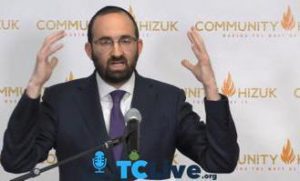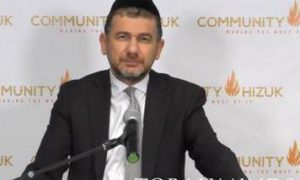“People stepped up to the plate in the most amazing ways. Collectively, all hats – white, black – were thrown in the garbage and we united as one.” – Rabbi David Ozeri
“…it was also be remembered as a time of unparalleled unity, a time when our community showed what makes it so unique, when we all banded together even under quarantine to help each other…”
Our Community’s response to the Covid-19 crisis will inspire many future generations, teaching them what being a Community is all about
Mozelle Forman
Eventually, please Gd, this is going to an end.
We do not know when or how, but we can be confident that sooner or later, the chaos and upheaval wrought by the coronavirus pandemic will be over, and life will, slowly but surely, return to normalcy.
What will we remember? Will we remember “shelter in place,” or that we had shelter? Will the feelings of fear, helplessness, despair, and grief pervade our memories, or will we recall the courage, selflessness, and generosity displayed by so many of our community members? Will we recall the ever-changing news flooding our inboxes that kept us on an emotional rollercoaster, or the sentimental stories of those who reached out and helped?
Our community’s extraordinary, heroic efforts over the past two months have all but guaranteed that this unprecedented period will be remembered as a time of strength, unity, and hope, and its memory will serve as an everlasting source of pride and inspiration for our community and for the Jewish world.
Closeness in a Time of Social Distancing
In a few short weeks, from when we first heard about the coronavirus in China in January, believing it was a foreign issue, until right after Purim, when over a dozen community members tested positive, we were thrust into a surreal existence, our thoughts vacillating between “this can’t be happening” to “what do we do now?”
While government officials were trying to devise a strategy for combatting this virus and issuing guidelines about “social distancing,” our community leaders arranged an emergency meeting to discuss the steps necessary to adhere to these guidelines. Excruciating decisions about our way of life had to be made. “Social distancing” eliminates virtually every aspect of communal life – prayer services, schools, yeshivot, adult education, youth programming, semahot, and social events. But after meeting with doctors, the difficult decision was made to close shuls and yeshivot, and to advise the community to stay at home. Rabbis, educators, and community leaders now to had to advise the community and institute provisions for the “new normal.”
Confined to our homes, separated from those we love, and exiled from our shuls and yeshivot, we could have fallen into despair. But through the ingenuity and fortitude of our rabbinic and lay leaders, instead of becoming disconnected from our Torah and our community, we remained as connected as ever, and inspired like never before.
Literally overnight, two new websites, TcLive.org and Communityhizuk.com, were created. Our rabbis and teachers filled our homes, virtually, with knowledge, wisdom, and inspiration. The Tclive.org website offered a virtual buffet of Torah learning with daily livestream Daf Yomi, mussar and halachah classes, simulating our community’s vibrant Torah centers. In addition, an extraordinary children’s program was created with an average of six classes per evening on topics such as Mishnah, Pirkeh Avot, and te’amim. The children’s programming includes a game show night with questions based on what was studied during the week, and a raffle drawing.
Combatting the “Negative Energy”
 Communityhizuk.com was spearheaded by Rabbi David Haber, and he described the line of thinking that led him to undertake this unique project. “My feeling was that if we were going to be inundated with fear of mortal danger and negative energy, we needed our rabbis to provide the hizuk [encouragement] to withstand it.”
Communityhizuk.com was spearheaded by Rabbi David Haber, and he described the line of thinking that led him to undertake this unique project. “My feeling was that if we were going to be inundated with fear of mortal danger and negative energy, we needed our rabbis to provide the hizuk [encouragement] to withstand it.”
Rabbi Haber says he literally spent an entire night contacting rabbis and lay people with his idea, and received an overwhelmingly positive response.
“Everyone I spoke to was onboard, especially our hardworking rabbis. Although we had no idea if anyone would be listening and who our audience would be, we had over 60,000 viewers and listeners across several platforms on the first night.”
CommunityHizuk.com spoke to the moment – everyone was searching for answers, and this platform provided an oasis in the desert.
“We are blessed to have such hardworking, dedicated rabbis in our community,” Rabbi Haber enthuses, “rabbis who love the community, know their role as community leaders, and work tirelessly on our behalf. The selflessness of all those involved with many platforms, who in ‘normal’ times would actually have been competitors, was evident, as we all joined together and worked seamlessly to touch so many lives in such a powerful way.”
Another platform created in this time of unknowing was Torahminds.com, which, according to Rabbi Meyer Yedid, Rosh Yeshiva of YDE, sought “to give people the ability to learn in an organized and in-depth way, to study mitzvot they already observe on a deeper level.”
The response to this initiative was swift and electric. As soon as it was publicized, over 5,000 people joined and committed to studying one of the ten topics offered by the program.
Rabbi Yedid was also instrumental in organizing a livestream presentation entitled, “Prayer through Songs.” In his opening remarks, the rabbi stated: “When you want to give over a deep message, words are sometimes not enough. Music, the language of the angels, touches the soul.”
Outpouring of Generosity
 The combination of a shut-down economy, plummeting stock market, and widespread unemployment could have spelled disaster for our community organizations that rely on donations to fund their budgets. However, Rabbi David Ozeri described a very different picture.
The combination of a shut-down economy, plummeting stock market, and widespread unemployment could have spelled disaster for our community organizations that rely on donations to fund their budgets. However, Rabbi David Ozeri described a very different picture.
“To say I am proud of our community is an understatement,” the rabbi glowingly shared. “People stepped up to the plate in the most amazing ways. Collectively, all hats – white, black – were thrown in the garbage and we united as one. Millions of dollars were donated and distributed, especially to widows and orphans, including $50,000 of Moishe’s grocery cards.”
In a wondrous intersection of technology and tzedakah, the Communityhizuk website hosted a campaign for Sephardic Bikur Holim that raised $2.4 million dollars. In addition, a relief fund was organized, raising $400,000 to help families ravaged by the dramatic financial collapse.
Tragically, out community suffered 80 fatalities in the period between March 20th to May 1st – a staggering figure. Funeral homes were overwhelmed, and a large number of community members volunteered to ensure that everyone received a proper, respectful burial, and that all mourners were cared for, despite the restrictions which did not allow for customary funerals or shivah visits. With flights to Israel halted, those who died but were destined to be buried in Israel were temporarily interred in Queens. After Pesah, the Nakash family generously offered to bring the deceased to Israel for burial. Rabbi Ozeri, who was integrally involved throughout this time in all aspects of the process of kevod hamet (last respects for the deceased), personally oversaw the exhumation of seven coffins which were then flown to their final resting place in Israel, bringing closure and comfort to all the families. The Nakash family sent many more flights, as well.
Our community’s technology experts donated their time and their brilliance, working behind the scenes to ensure glitch-free virtual programming. Koby Netanel of Koby N Productions, who has been behind every livestream Torah shiur, talks about the experience of fueling the technology needed to keep the community connected during this crisis.
 “I must acknowledge how honored and blessed I feel to be trusted by the community to oversee this tremendous endeavor. The rabbis, eager to have a platform to reach the community and give them hizuk, were subject to a learning curve as they learned about the technology for livestreaming, and we had a few bloopers. I myself had to become familiar with the technology and software needed to livestream events and incorporate call-ins and Zoom. While all the classes are recorded and available on several websites, there is something exciting about being there ‘in person’.”
“I must acknowledge how honored and blessed I feel to be trusted by the community to oversee this tremendous endeavor. The rabbis, eager to have a platform to reach the community and give them hizuk, were subject to a learning curve as they learned about the technology for livestreaming, and we had a few bloopers. I myself had to become familiar with the technology and software needed to livestream events and incorporate call-ins and Zoom. While all the classes are recorded and available on several websites, there is something exciting about being there ‘in person’.”
Koby’s brother, Rabbi Raphael Netanel of YDE, marvels at Koby’s selfless dedication, and provides us with a little background.
“About three months before the virus hit, a local girls high school hired Koby to run the sound for the annual play. One week before the play, the principal contacted Koby to ask if he would be able to livestream the play for a 10th-grade student who was in the hospital fighting cancer. Touched by the girl’s struggle, Koby couldn’t refuse.”
The fact that he didn’t have the necessary equipment for livestreaming did not stop him.
“He purchased $3,000 worth of livestream equipment and software that was needed. The girl’s parents and the principal thanked him profusely. Koby then stored the equipment in a closet in his office with no intention of using it again, as his business did not require it. When Covid-19 hit and he was contacted about livestreaming classes, Koby knew exactly where to go – to the closet where he stored the “useless” equipment purchased to make a young girl with cancer happy.
Hashem is always “makdim terufah lamakah,” sending us the “remedy” before the “wound.” We are so blessed that the technology we needed to keep us connected and growing in this time of physical isolation was available and in place before the pandemic struck. And we ae so blessed that Gd sent us creative, generous and dedicated leaders and professionals who rose to the challenge and succeeded in keeping our community together against all odds.
How will this historic time be remembered in the annals of our community? Yes, it will be remembered as a time of tragedy, of pain, of fear, of personal loss, and of economic turmoil. But it was also be remembered as a time of unparalleled unity, a time when our community showed what makes it so unique, when we all banded together even under quarantine to help each other, to support each other, to learn from each other, to grow together, and to comfort each other.
Our community’s amazing response is, without question, setting a precedent and model that will, with Gd’s help, guide and inspire many future generations, teaching them what being a community is all about.



